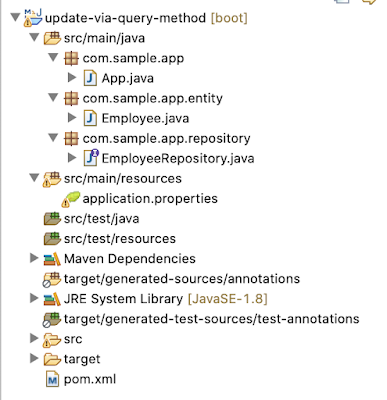Spring-data-jpa supports update operation using query method.
How to update entities using query method?
Define the repository method using @Query and @Modifying annotations. One more thing to note here is, all the update/delete operations should be called in a transaction scope.
Note
By default, CRUD methods (CrudRepository methods) are marked as transactional. If you are using custom query methods then you should explicitly mark it with @Transactional annotation.
Example 1: Update employee firstName and lastName using id.
@Transactional
@Modifying
@Query("update Employee e set e.firstName = ?1, e.lastName = ?2 where e.id = ?3")
int updateUserNameById(String firstname, String lastname, Integer userId);
Example 2: Update all the employees age by 1.
@Transactional
@Modifying
@Query("update Employee e set e.age = e.age+1")
int updateEmpsAgeBy1();
Find the below working application.
Step 1: Create new maven project ‘update-via-query-method’.
Step 2: Update pom.xml with maven dependencies.
pom.xml
<project xmlns="http://maven.apache.org/POM/4.0.0"
xmlns:xsi="http://www.w3.org/2001/XMLSchema-instance"
xsi:schemaLocation="http://maven.apache.org/POM/4.0.0 https://maven.apache.org/xsd/maven-4.0.0.xsd">
<modelVersion>4.0.0</modelVersion>
<groupId>com.sample.app</groupId>
<artifactId>update-via-query-method</artifactId>
<version>1</version>
<parent>
<groupId>org.springframework.boot</groupId>
<artifactId>spring-boot-starter-parent</artifactId>
<version>2.4.0</version>
</parent>
<properties>
<project.build.sourceEncoding>UTF-8</project.build.sourceEncoding>
</properties>
<dependencies>
<dependency>
<groupId>org.springframework.boot</groupId>
<artifactId>spring-boot-starter-data-jpa</artifactId>
</dependency>
<dependency>
<groupId>com.h2database</groupId>
<artifactId>h2</artifactId>
</dependency>
</dependencies>
</project>
Step 3: Create application.properties file under src/main/resources folder.
application.properties
logging.level.root=WARN logging.level.org.hibernate=ERROR ## H2 specific properties spring.h2.console.enabled=true spring.h2.console.path=/h2 spring.datasource.url=jdbc:h2:file:~/db/myOrg.db;DB_CLOSE_ON_EXIT=FALSE;DB_CLOSE_DELAY=-1; spring.datasource.username=krishna spring.datasource.password=password123 spring.datasource.driverClassName=org.h2.Driver ## JPA specific properties # Creates the schema, destroying previous data. spring.jpa.hibernate.ddl-auto=create spring.jpa.database-platform=org.hibernate.dialect.H2Dialect spring.jpa.show-sql=false spring.jpa.properties.hibernate.format_sql=false ## Database connection pooling properties # Number of ms to wait before throwing an exception if no connection is available. spring.datasource.max-wait=10000 # Maximum number of active connections that can be allocated from this pool at the same time. spring.datasource.tomcat.max-active=10 spring.datasource.tomcat.max-idle=5 spring.datasource.tomcat.min-idle=3
Step 4: Define Employee entity.
Employee.java
package com.sample.app.entity;
import javax.persistence.Column;
import javax.persistence.Entity;
import javax.persistence.GeneratedValue;
import javax.persistence.GenerationType;
import javax.persistence.Id;
import javax.persistence.Table;
@Entity
@Table(name = "my_employee")
public class Employee {
@Id
@GeneratedValue(strategy = GenerationType.AUTO)
private int id;
@Column(name = "first_name")
private String firstName;
@Column(name = "last_name")
private String lastName;
@Column(name = "age")
private int age;
@Column(name = "salary")
private double salary;
public int getId() {
return id;
}
public void setId(int id) {
this.id = id;
}
public String getFirstName() {
return firstName;
}
public void setFirstName(String firstName) {
this.firstName = firstName;
}
public String getLastName() {
return lastName;
}
public void setLastName(String lastName) {
this.lastName = lastName;
}
public int getAge() {
return age;
}
public void setAge(int age) {
this.age = age;
}
public double getSalary() {
return salary;
}
public void setSalary(double salary) {
this.salary = salary;
}
public static EmployeeBuilder builder() {
return new EmployeeBuilder();
}
public static class EmployeeBuilder {
private Employee emp;
public EmployeeBuilder() {
emp = new Employee();
}
public EmployeeBuilder firstName(String firstName) {
emp.setFirstName(firstName);
return this;
}
public EmployeeBuilder lastName(String lastName) {
emp.setLastName(lastName);
return this;
}
public EmployeeBuilder age(int age) {
emp.setAge(age);
return this;
}
public EmployeeBuilder salary(double salary) {
emp.setSalary(salary);
return this;
}
public Employee build() {
return emp;
}
}
@Override
public String toString() {
StringBuilder builder = new StringBuilder();
builder.append("Employee [id=").append(id).append(", firstName=").append(firstName).append(", lastName=")
.append(lastName).append(", age=").append(age).append(", salary=").append(salary).append("]");
return builder.toString();
}
}
Step 5: Define EmployeeRepository interface.
EmployeeRepository.java
package com.sample.app.repository;
import javax.transaction.Transactional;
import org.springframework.data.jpa.repository.JpaRepository;
import org.springframework.data.jpa.repository.Modifying;
import org.springframework.data.jpa.repository.Query;
import com.sample.app.entity.Employee;
public interface EmployeeRepository extends JpaRepository<Employee, Integer>{
@Transactional
@Modifying
@Query("update Employee e set e.firstName = ?1, e.lastName = ?2 where e.id = ?3")
int updateUserNameById(String firstname, String lastname, Integer userId);
@Transactional
@Modifying
@Query("update Employee e set e.age = e.age+1")
int updateEmpsAgeBy1();
}
Step 6: Define main application class.
App.java
package com.sample.app;
import java.util.Arrays;
import java.util.List;
import org.springframework.boot.CommandLineRunner;
import org.springframework.boot.SpringApplication;
import org.springframework.boot.autoconfigure.SpringBootApplication;
import org.springframework.context.annotation.Bean;
import com.sample.app.entity.Employee;
import com.sample.app.repository.EmployeeRepository;
@SpringBootApplication
public class App {
public static void main(String args[]) {
SpringApplication.run(App.class, args);
}
public void printEmployees(Iterable<Employee> emps, String msg) {
System.out.println(msg);
for (Employee emp : emps) {
System.out.println(emp);
}
System.out.println();
}
@Bean
public CommandLineRunner demo(EmployeeRepository employeeRepository) {
return (args) -> {
Employee emp1 = Employee.builder().firstName("Ram").lastName("Gurram").age(32).salary(100000.23).build();
Employee emp2 = Employee.builder().firstName("Ram").lastName("Chelli").age(43).salary(60000).build();
Employee emp3 = Employee.builder().firstName("Gopi").lastName("Battu").age(45).salary(1000000).build();
Employee emp4 = Employee.builder().firstName("Ram").lastName("Srikanth").age(39).salary(60000).build();
Employee emp5 = Employee.builder().firstName("Surendra").lastName("Sami").age(32).salary(100000.23).build();
employeeRepository.save(emp1);
employeeRepository.save(emp2);
employeeRepository.save(emp3);
employeeRepository.save(emp4);
employeeRepository.save(emp5);
List<Employee> emps = employeeRepository.findAll();
printEmployees(emps, "All the employees information");
int updatedRecords = employeeRepository.updateUserNameById("John", "Charter", 1);
if (updatedRecords == 1) {
Employee emp = employeeRepository.findById(1).get();
printEmployees(Arrays.asList(emp), "Employee with id 1 details");
} else {
System.out.println("Failed to update");
}
updatedRecords = employeeRepository.updateEmpsAgeBy1();
System.out.println("Total updated record : " + updatedRecords);
emps = employeeRepository.findAll();
printEmployees(emps, "All the employees information");
};
}
}
Total project structure looks like below.
Run App.java, you will see below messages in console.
All the employees information Employee [id=1, firstName=Ram, lastName=Gurram, age=32, salary=100000.23] Employee [id=2, firstName=Ram, lastName=Chelli, age=43, salary=60000.0] Employee [id=3, firstName=Gopi, lastName=Battu, age=45, salary=1000000.0] Employee [id=4, firstName=Ram, lastName=Srikanth, age=39, salary=60000.0] Employee [id=5, firstName=Surendra, lastName=Sami, age=32, salary=100000.23] Employee with id 1 details Employee [id=1, firstName=John, lastName=Charter, age=32, salary=100000.23] Total updated record : 5 All the employees information Employee [id=1, firstName=John, lastName=Charter, age=33, salary=100000.23] Employee [id=2, firstName=Ram, lastName=Chelli, age=44, salary=60000.0] Employee [id=3, firstName=Gopi, lastName=Battu, age=46, salary=1000000.0] Employee [id=4, firstName=Ram, lastName=Srikanth, age=40, salary=60000.0] Employee [id=5, firstName=Surendra, lastName=Sami, age=33, salary=100000.23]
You can download complete working application from below link.
https://github.com/harikrishna553/springboot/tree/master/jpa/update-via-query-method

No comments:
Post a Comment